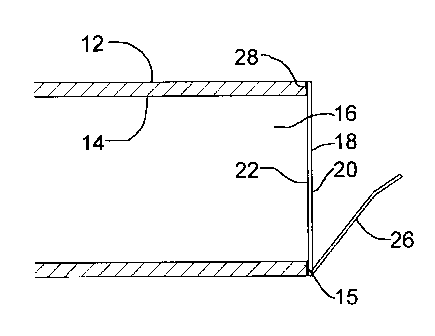Some of the information on this Web page has been provided by external sources. The Government of Canada is not responsible for the accuracy, reliability or currency of the information supplied by external sources. Users wishing to rely upon this information should consult directly with the source of the information. Content provided by external sources is not subject to official languages, privacy and accessibility requirements.
Any discrepancies in the text and image of the Claims and Abstract are due to differing posting times. Text of the Claims and Abstract are posted:
| (12) Patent: | (11) CA 2633165 |
|---|---|
| (54) English Title: | SEAL FOR PRESSURE TESTING A PLUMBING INSTALLATION AND METHOD OF USE THEREOF |
| (54) French Title: | JOINT D'ETANCHEITE PERMETTANT DE VERIFIER LA PRESSION D'UNE INSTALLATION DE PLOMBERIE, ET METHODE D'UTILISATION CONNEXE |
| Status: | Granted and Issued |
| (51) International Patent Classification (IPC): |
|
|---|---|
| (72) Inventors : |
|
| (73) Owners : |
|
| (71) Applicants : |
|
| (74) Agent: | NATHAN V. WOODRUFFWOODRUFF, NATHAN V. |
| (74) Associate agent: | |
| (45) Issued: | 2015-05-26 |
| (22) Filed Date: | 2008-05-29 |
| (41) Open to Public Inspection: | 2009-11-29 |
| Examination requested: | 2013-05-06 |
| Availability of licence: | N/A |
| Dedicated to the Public: | N/A |
| (25) Language of filing: | English |
| Patent Cooperation Treaty (PCT): | No |
|---|
| (30) Application Priority Data: | None |
|---|
A method for testing the integrity of a plumbing system. A first step involves affixing a seal with a releasable adhesive over a component of the plumbing system having a bore to occlude the bore. A second step involves charging the plumbing system with a fluid.
Une méthode pour vérifier lintégrité dune installation de plomberie. Une première étape comporte la pose dun joint détanchéité avec un adhésif décollable sur un composant de linstallation de plomberie avec un calibre pour occlure lalésage. Une seconde étape comporte de charger linstallation de plomberie avec un fluide.
Note: Claims are shown in the official language in which they were submitted.
Note: Descriptions are shown in the official language in which they were submitted.

2024-08-01:As part of the Next Generation Patents (NGP) transition, the Canadian Patents Database (CPD) now contains a more detailed Event History, which replicates the Event Log of our new back-office solution.
Please note that "Inactive:" events refers to events no longer in use in our new back-office solution.
For a clearer understanding of the status of the application/patent presented on this page, the site Disclaimer , as well as the definitions for Patent , Event History , Maintenance Fee and Payment History should be consulted.
| Description | Date |
|---|---|
| Inactive: COVID 19 - Deadline extended | 2020-05-14 |
| Common Representative Appointed | 2019-10-30 |
| Common Representative Appointed | 2019-10-30 |
| Grant by Issuance | 2015-05-26 |
| Inactive: Cover page published | 2015-05-25 |
| Inactive: Final fee received | 2015-03-04 |
| Pre-grant | 2015-03-04 |
| Letter Sent | 2014-09-10 |
| Notice of Allowance is Issued | 2014-09-10 |
| Notice of Allowance is Issued | 2014-09-10 |
| Inactive: Approved for allowance (AFA) | 2014-08-19 |
| Inactive: Q2 passed | 2014-08-19 |
| Amendment Received - Voluntary Amendment | 2014-07-02 |
| Inactive: S.30(2) Rules - Examiner requisition | 2014-01-31 |
| Inactive: Report - No QC | 2014-01-30 |
| Letter Sent | 2013-05-08 |
| All Requirements for Examination Determined Compliant | 2013-05-06 |
| Request for Examination Received | 2013-05-06 |
| Request for Examination Requirements Determined Compliant | 2013-05-06 |
| Inactive: Office letter | 2011-05-16 |
| Inactive: Office letter | 2011-05-16 |
| Letter Sent | 2010-07-08 |
| Inactive: Office letter | 2010-03-23 |
| Inactive: Cover page published | 2009-11-29 |
| Application Published (Open to Public Inspection) | 2009-11-29 |
| Inactive: IPC assigned | 2009-11-20 |
| Inactive: IPC assigned | 2009-07-29 |
| Inactive: First IPC assigned | 2009-07-29 |
| Inactive: IPC assigned | 2009-07-29 |
| Inactive: IPC assigned | 2009-07-29 |
| Inactive: IPC assigned | 2009-02-16 |
| Application Received - Regular National | 2008-07-08 |
| Filing Requirements Determined Compliant | 2008-07-08 |
| Inactive: Filing certificate - No RFE (English) | 2008-07-08 |
| Small Entity Declaration Determined Compliant | 2008-05-29 |
There is no abandonment history.
The last payment was received on 2015-02-11
Note : If the full payment has not been received on or before the date indicated, a further fee may be required which may be one of the following
Please refer to the CIPO Patent Fees web page to see all current fee amounts.
Note: Records showing the ownership history in alphabetical order.
| Current Owners on Record |
|---|
| GABE COSCARELLA |
| Past Owners on Record |
|---|
| None |